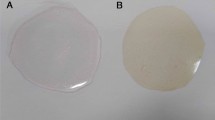Abstract
Antibacterial effect of chitooligosaccharides (COS) and low molar mass chitosans (LMWC) is considered as one of the most important characteristics of chitosan (CS) hydrolysates. Here, we show the in vitro effect of different COS, LMWC, and CS on representative anaerobic bacteria isolated from human colon as a possibility of targeting modification of colonic microflora composition by supplementation of dietary CS products by humans. Specific growth rate of seven selected nonpathogenic anaerobic bacterial strains (Clostridium paraputrificum, Clostridium beijerinckii, Roseburia intestinalis, Bacteroides vulgatus, Bacteriodes thetaiotaomicron, Faecalibacterium prausnitzii and Blautia coccoides) was determined in the presence of 0.25 and 0.5% COS (2, 3, and 6 kDa), 0.025 and 0.05% of LMWC (10 and 16 kDa), and 0.025 and 0.1% of CS in vitro. The growth rate decreased in all strains in the presence of COS and LMWC in higher concentrations in comparison to control incubations. A relatively higher resistance to CS hydrolyzates was detected in R. intestinalis and F. prausnitzii, and more susceptible were bacteria belonging to Bacteoides sp. and Clostridium sp. The antimicrobial activity, minimum inhibitory concentrations (MIC), and minimal bactericidal concentrations (MBC) were determined. The antimicrobial activity increased with the degree of polymerization (DP). MIC ranged from 0.25 to 4.5% in dependence on bacterial strain and DP of CS/LMWC. MBC also decreased with DP. The most effective antimicrobial action was detected in LMWC with 16 kDa and CS. Weak antimicrobial activity was found in COS with small molecules (2 and 3 kDa).
Similar content being viewed by others
References
Alverdy JC, Chang EB (2008) The re-emerging role of the intestinal microflora in critical illness and inflammation: why the gut hypothesis of sepsis syndrome will not go away. J Leukoc Biol 83:461–466
Bernkop D, Schnurch A (2000) Chitosan and its derivatives: potential excipients for peroral peptide delivery systems. Int J Pharmaceut 194:1–13
Fernandes JC, Tavaria FK, Soares JC, Ramos OS, Monteiro MJ, Pintado ME, Malcata FX (2008) Antimicrobial effects of chitosan and chitooligosaccharides, upon Staphylococcus aureus and Escherichia coli, in food model systems. Food Microbiol 25:922–928. doi:10.1016/j.fm.2008.05.003
Gerasimenko DV, Avdienko ID, Bannikova GE, Zueva OY, Varlamov VP (2004) Antibacterial effects of water-soluble low molecular-weight chitosans on different microorganisms. Appl Biochem Microbiol 40:253–257. doi:10.1023/B:ABIM.0000025947.84650.b4
Han KN, Kwon IK, Lohakare JD, Heo S, Chae BJ (2007) Chito-oligosaccharides as an alternative to antimicrobials in improving performance, digestibility and microbial ecology of the gut in weaning pigs. Asian-Australasian J Anim Sci 20:556–562
Hu Y, Du Y, Yang J, Kennedy JF, Wang X, Wang L (2007) Synthesis, characterization and antibacterial activity of guanidinylated chitosan. Carbohydr Polym 67:66–72
Jeon YJ, Park PJ, Kim SK (2001) Antimicrobial effect of chitooligosaccharides produced by bioreactor. Carbohyd Polym 44:71–76. doi:10.1016/S0144-8617(00)00200-9
Kim SK, Rajapakse N (2005) Enzymatic production and biological activities of chitosan oligosaccharides (COS): a review. Carbohydr Polym 62:357–368. doi:10.1016/j.carbpol.2005.08.012
Kittur FS, Kumar ABV, Vadaraj MC, Tharanathan RN (2005) Chitooligosaccharides—preparation with the aid of pectinase isozyme from Aspergillus niger and their antibacterial activity. Carbohydr Res 340:1239–1245. doi:10.1016/j.carres.2005.02.005
Kopecny J, Hodrova B, Stewart CS (1996) The isolation and characterization of a rumen chitinolytic bacterium. Lett Appl Microbiol 23:195–198
Lee HW, Park YS, Jung JS, Shin WS (2002) Chitosan oligosaccharides, dp 2–8, have probiotic effect on the Bifidobacterium bifidum and Lactobacillis sp. Anaerobe 8:319–324. doi:10.1016/S1075-9964(03)00030-1
No HK, Park NY, Lee SH, Meyers SP (2002) Antibacterial activity of chitosans and chitosan oligomers with different molecular weights. Int J Food Microbiol 74:65–72. doi:10.1016/S0168-1605(01)00717-6
Park PJ, Lee HK, Kim SK (2004) Preparation of hetero-chitooligosaccharides and their antimicrobial activity on Vibrio parahemolyticus. J Microbiol Biotechnol 14:41–47
Possemiers S, Grootaert C, Vermeiren J, Gross G, Marzorati M, Verstraete W, Van de Wiele T (2009) The intestinal environment in health and disease—recent insights on the potential of intestinal bacteria to influence human health. Curr Pharmaceut Design 15:2051-2065. Bentham Sci Publish Ltd. COD: CPDEFP
Preidis GA, Versalovic J (2009) Targeting the human microbiome with antibiotics, probiotics, and prebiotics: gastroenterology enters the metagenomics era. Gastroenterology 136:2015–2031. doi:10.1053/j.gastro.2009.01.072
Rabea EI, Badawy ET, Stevens CV, Smagghe G, Steurbaut W (2003) Chitosan as antimicrobial agent: applications and mode of action. Biomacromolecules 4:1457–1465. doi:10.1021/bm034130m
Rhoades J, Roller S (2000) Antimicrobial actions of degraded and native chitosan against spoilage organisms in laboratory media and foods. Appl Environ Microbiol 66:80–86
Šimůnek J, Tishchenko G, Hodrová B, Bartoňová H (2006) Effect of Chitosan on the growth of human colonic bacteria. Folia Microbiol 51:306–308. doi:10.1007/BF02931820
Šimůnek J, Koppová I, Lukáš F, Tischenko G, Belzecki G (2010) The antimicrobial action of low molar mass chitosan, chitosan derivatives and chitooligosaccharides on Bifidobacteria. Folia Microbiol 55:379–382
Tsai G-J, Hwang S-P (2004) In vitro and in vivo antibacterial activity of shrimp chitosan against some intestinal bacteria. Fish Sci 70:675–681. doi:10.1111/j.1444-2906.2004.00856.x
Vernazza CL, Gibson GR, Rastall RA (2005) In vitro fermentation of chitosan derivatives by mixed cultures of human fecal bacteria. Carbohydr Polym 60:539–545. doi:10.1016/j.carbpol.2005.03.008
Wang GH (1992) Inhibition and inactivation of 5 species of foodborne pathogens by chitosan. J Food Protect 55:916–919
Wang Y, Zhou P, Yu J, Pan X, Wang P, Lan W, Tao S (2007) Antimicrobial effect of chitooligosaccharides produced by chitosanase from Pseudomonas CUY8. Asia Pac J Clin Nutr 16:174–177
Acknowledgments
This work was supported by the Grant Agency of the Czech Republic (project no. 525/08/0803).
Author information
Authors and Affiliations
Corresponding author
Rights and permissions
About this article
Cite this article
Šimůnek, J., Brandysová, V., Koppová, I. et al. The antimicrobial action of chitosan, low molar mass chitosan, and chitooligosaccharides on human colonic bacteria. Folia Microbiol 57, 341–345 (2012). https://doi.org/10.1007/s12223-012-0138-1
Received:
Accepted:
Published:
Issue Date:
DOI: https://doi.org/10.1007/s12223-012-0138-1




